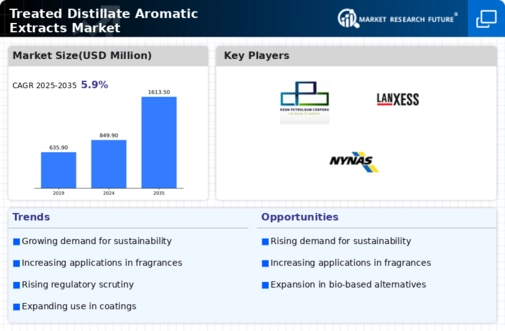Market Analysis
In-depth Analysis of Treated Distillate Aromatic Extracts (TDAE) Market Industry Landscape
The market dynamics of Treated Distillate Aromatic Extracts (TDAE) are influenced by various factors that shape its growth, trends, and overall trajectory.
Automotive Industry Demand: The automotive industry represents a significant driver of demand for Treated Distillate Aromatic Extracts (TDAE). Market dynamics within the automotive sector, such as production volumes, vehicle sales, and tire manufacturing activities, directly impact the demand for TDAE as a crucial raw material in tire manufacturing. Economic conditions, consumer preferences, and regulatory requirements affecting the automotive industry influence the TDAE market dynamics.
Tire Manufacturing Trends: TDAE is widely used in the tire manufacturing industry due to its desirable properties such as low aromatic content, high viscosity, and excellent processability. Market dynamics within the tire manufacturing sector, such as tire demand, tire size preferences, and tire performance requirements, drive the demand for TDAE. Market dynamics related to tire manufacturing trends include innovations in tire technology, advancements in rubber compounding, and shifts towards eco-friendly tire formulations.
Regulatory Environment: The regulatory environment, including environmental regulations, product safety standards, and chemical restrictions, impacts the TDAE market dynamics. Compliance with regulatory requirements and certifications is essential for TDAE manufacturers and users to ensure product safety and environmental sustainability. Market dynamics related to regulatory changes include the adoption of eco-friendly manufacturing practices, the implementation of emission controls, and the development of sustainable solutions in the TDAE market.
Raw Material Availability: Raw material availability and pricing dynamics influence the TDAE market dynamics. Market dynamics related to raw material availability include fluctuations in crude oil prices, supply chain disruptions, and geopolitical factors affecting the availability of feedstocks for TDAE production. TDAE manufacturers monitor market dynamics in the petrochemical industry to anticipate changes in raw material prices and availability, which impact production costs and market competitiveness.
Competitive Landscape: Market competition among TDAE manufacturers and suppliers shapes market dynamics such as pricing strategies, product differentiation, and market positioning. Competitive dynamics drive companies to innovate, improve product quality, and offer value-added services to gain a competitive edge. Market dynamics related to competition include mergers and acquisitions, strategic alliances, and partnerships aimed at expanding market reach and strengthening market presence in the TDAE market.
Technological Advancements: Technological advancements play a significant role in shaping the TDAE market dynamics. Innovations in refining processes, chemical treatments, and product formulations improve the quality, performance, and sustainability of TDAE products. Market dynamics driven by technological advancements include the development of low PAH (polycyclic aromatic hydrocarbon) formulations, the optimization of extraction methods, and the introduction of environmentally friendly processing technologies in the TDAE market.
Shift towards Green and Sustainable Solutions: Market dynamics in the TDAE market reflect a growing demand for green and sustainable solutions. Environmental sustainability considerations drive market dynamics related to the adoption of renewable feedstocks, bio-based alternatives, and eco-friendly manufacturing practices in TDAE production. Market players respond to market dynamics by developing environmentally friendly TDAE products that meet regulatory requirements and address customer preferences for sustainable materials.
End-User Preferences and Demands: End-user preferences and demands influence market dynamics in the TDAE market. Tire manufacturers and other end-users seek TDAE products that meet specific performance requirements, such as low rolling resistance, improved traction, and enhanced durability. Market dynamics related to end-user preferences include the demand for customized TDAE formulations, technical support services, and supply chain reliability to meet production needs and market demands.
Global Economic Conditions: Global economic conditions, including GDP growth, trade policies, and currency fluctuations, impact the TDAE market dynamics. Economic fluctuations and uncertainties can affect tire demand, industrial activities, and consumer spending patterns, leading to changes in TDAE market dynamics. Market players monitor global economic trends to anticipate market shifts and adapt their strategies accordingly to maintain market competitiveness and profitability.
Emerging Markets and Opportunities: Emerging markets and growth opportunities present new avenues for market expansion and development in the TDAE market. Market dynamics in emerging economies, such as China, India, Brazil, and Southeast Asian countries, offer growth opportunities for TDAE manufacturers and suppliers. Rapid industrialization, infrastructure development, and urbanization drive demand for tires and TDAE products in these markets, creating new opportunities for market players to expand their presence and capture market share.

















Leave a Comment